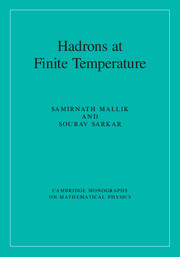Book contents
- Frontmatter
- Dedication
- Contents
- Preface
- Notation
- 1 Free Fields in Vacuum
- 2 Spontaneous Symmetry Breaking
- 3 Chiral Perturbation Theory
- 4 Thermal Propagators
- 5 Thermal Perturbation Theory
- 6 Thermal Parameters
- 7 Two-Loop Results
- 8 Heavy Ion Collisions
- 9 Non-Equilibrium Processes
- Appendix A General Fields
- Appendix B Global Symmetries
- Appendix C Exponential Operator
- Appendix D Propagator at Origin of Coordinates
- Appendix E Reaction Rates in Vacuum and Medium
- Appendix F Coupling Constants
- Appendix G Imaginary Time Method
- Appendix H Quark Condensate from Partition Function
- Appendix I Quark Condensate from Density Expansion
- Index
- References
3 - Chiral Perturbation Theory
Published online by Cambridge University Press: 27 October 2016
- Frontmatter
- Dedication
- Contents
- Preface
- Notation
- 1 Free Fields in Vacuum
- 2 Spontaneous Symmetry Breaking
- 3 Chiral Perturbation Theory
- 4 Thermal Propagators
- 5 Thermal Perturbation Theory
- 6 Thermal Parameters
- 7 Two-Loop Results
- 8 Heavy Ion Collisions
- 9 Non-Equilibrium Processes
- Appendix A General Fields
- Appendix B Global Symmetries
- Appendix C Exponential Operator
- Appendix D Propagator at Origin of Coordinates
- Appendix E Reaction Rates in Vacuum and Medium
- Appendix F Coupling Constants
- Appendix G Imaginary Time Method
- Appendix H Quark Condensate from Partition Function
- Appendix I Quark Condensate from Density Expansion
- Index
- References
Summary
It is interesting to note that much of the effective theory of strong interactions was developed well before the existence of QCD [1]. The isotopic spin symmetry of strong interactions was established long ago by works in nuclear physics. Modern developments began in 1960, when Nambu recognised the existence of nearly massless pions as a symptom of a spontaneously broken symmetry [2]. (This topic is reviewed in the previous chapter.) He and co-workers also showed how to calculate amplitudes involving a single pion [3]. In 1964 Gell-Mann introduced current algebra [4], which allowed the treating of processes involving more than a single pion. In particular, exact sum rules could be written for pion–hadron amplitudes, taking the pion to be massless [5, 6]. But for processes involving three or more pions, the calculations became complicated. Further, there was no way to treat approximate symmetries.
The numerical success of the sum rules did show that strong interactions must possess an underlying SU(2) × SU(2) symmetry broken to the SU(2) symmetry of isospin. In an attempt to find a simpler and more physical method of calculation, Weinberg [7] introduced in 1967 the effective Lagrangian incorporating this symmetry. Originally it was justified on the basis of current algebra: an effective Lagrangian with the symmetry of the underlying theory would produce conserved Noether currents in terms of the effective fields. These currents in turn would yield the equal-time commutators of current algebra. So if one calculates low energy amplitudes directly with this Lagrangian, it must yield the same results as from current algebra. The essential uniqueness of the effective Lagrangian was also established [8].
The QCD theory was proposed in 1972 by Fritzsch and Gell-Mann [1] as a theory of quarks and gluons. Soon after, Leutwyler [9] found that not only the mass difference of u and d quarks, but also the masses themselves, were small compared to the scale of strong interactions, which immediately explained the SU(2) × SU(2) symmetry of strong interactions. (Including the heavier s quark leads to a less accurate SU(3) × SU(3) symmetry.) The mass terms provide a definite pattern of symmetry breaking.
- Type
- Chapter
- Information
- Hadrons at Finite Temperature , pp. 49 - 93Publisher: Cambridge University PressPrint publication year: 2016



